Easy Sourdough Starter
This Easy Sourdough Starter recipe creates gorgeously fluffy homemade products such as Sourdough Baguettes. Included are simple step by step instructions on how to start, feed and Maintain Sourdough Starter that is perfect for beginners.
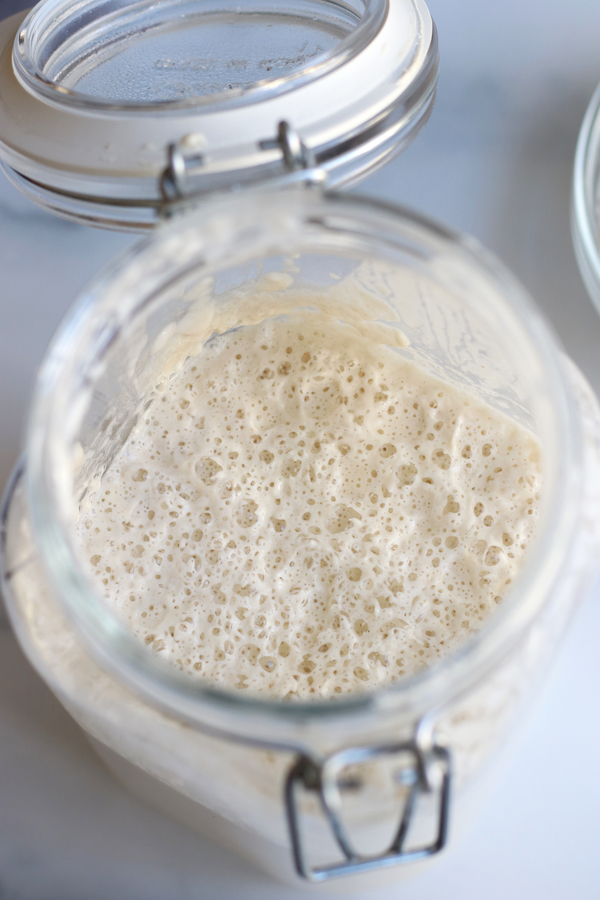
This post may contain affiliate links which I earn a small portion in sales if a purchase is made. Rest assured though, it is never at any additional cost to you.
What is Sourdough Starter
Very simply, sourdough starter is a fermented mixture of two ingredients, water and flour. Wild yeast found in flour flourishes when added to water and is allowed to rest in between feedings. This approach is the old fashioned way of making bread that has been done for centuries. It does require more time than active-dry or instant yeast but produces exceptional taste and textured baked goods.
Tools Needed
In addittion to the flour and water a few tools are needed to make your own from scratch Sourdough Starter.
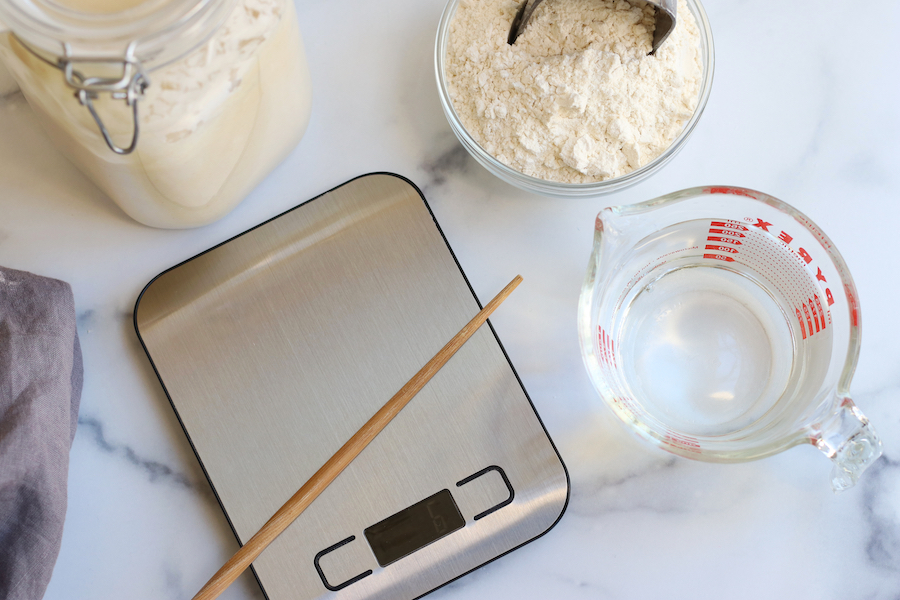
- Kitchen Scale- It is highly encouraged to use a kitchen scale to weigh the flour and water in equals parts to achieve the best results. This is the scale shown in the picture above. However, my next kitchen scale will be a little larger to accommodate the large bowl needed to make sourdough bread.
- Chopsticks– This makes stirring the starter in a glass jar much easier.
- Glass Measuring Cup– Makes for easy pouring of water.
- Scoop or Spoon– Helps with the addittion of flour.
- Medium Sized Glass Bowl– The first few days of a starters life is easier done in a medium size glass bowl.
- Plastic Wrap or Reusable Food Wraps– For the first few days of the starters life.
- Glass Jar (see below)
Sourdough Starter Container
The type of glass jar needed will depend on which type of flour you use to make your starter and how rapidly your starter ferments. This is the jar seen in the photo below and it works beautifully when using white all-purpose flour. Please see section directly below (White Flour vs Wheat Flour) for more explanation.
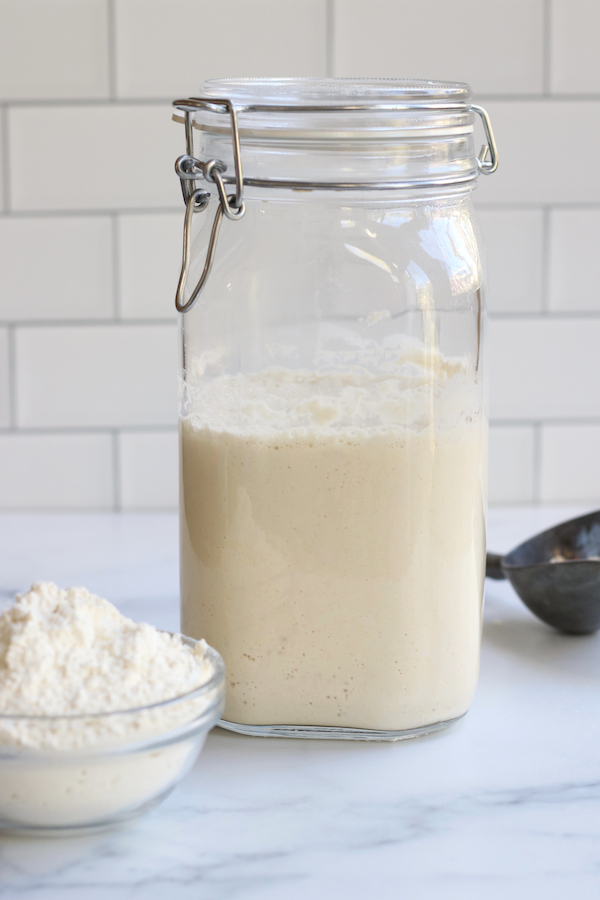
Best Flour for Sourdough Success
For the best sourdough starter, you need flour you can trust. Buying directly from King Arthur Flour means guaranteed freshness, expert-tested quality, and no risk of warehouse mishandling. Plus, you’ll find exclusive products, better stock availability, and support an employee-owned company dedicated to bakers. Skip the third-party markups and get the best right from the source. You and your sourdough deserve it! (affiliate)
White Flour vs Wheat Flour
The type of flour used will have a great influence on how your Stater ferments and the final product that you make with it. However, it is most important to not choose bleached flour as this will impede the fermentation.
All-Purpose White Flour
I adore sourdough bread that bites me back when I eat it. In other words, extra sour with a tang. However, my husband HATES that kind of bread. That is why I use all-purpose white flour for my Starter.
This type of flour yields breads that are very much like a crusty Italian loaf that he and I both go crazy for. Additionally, I use the Starter from this type of flour for making baguettes that then make incredible Homemade Breadcrumbs and croutons. The final products are never overly sour.
Wheat or Rye Flour
Wheat and rye flour has more naturally occurring wild yeast. Because of this, the starter made from these types of flours will ferment faster and with more intensity. It is very important to keep a closer eye on Starters made from these flours and to use a glass jar that has a lid that is looser or can be left slightly open. The reason for this, a tight fitting lid could be a recipe for an exploding jar.
In conclusion, wheat and rye flours will make much stronger sourdough products and all-purpose white flours (unbleached) will yield more mild final products.
How To Make
To make Sourdough Starter that is ready to bake with will take approximately 7 days, give or take a day or two. Here are the instructions for each day.
Day 1
In a medium sized glass bowl mix together 50 grams of water and 50 grams of flour. Stir well and cover. Let sit at room temperature.
Pro Tip#1– To accurately weigh the flour and water start by making sure the scale is weighing in grams vs ounces. Place the bowl on the scale and turn on. The scale should read zero with the the bowl on top. Add enough flour to equal 50 grams. Calibrate the scale back to zero again and repeat with water.
Pro Tip#2– In the making and feeding of this starter there will always be equal parts of flour and water added to it.
Day 2
To yesterday’s mixture add 50 grams of flour and 50 grams of water. Stir well and cover. Let sit at room temperature.
Day 3
Throw away half of the Starter. To the remaining Starter add 100 grams of flour and 100 grams of water. Stir well and cover. Let sit at room temperature.
Pro Tip#3– The discarded Starter from day 3- day 6 is not fully developed enough to have any uses. Simply throw it away.
Day 4
Throw away half of the starter. Add 150 grams of flour and 150 grams of water to the bowl and stir well. Cover and let sit at room temperature.
Pro Tip#4– Day 4 is the day that you will notice the mixture starting to take on the personality of a Sourdough Starter. There should be small bubbles and a slight sour smell will start to take shape.
Day 5
Similar to the previous days, throw away half of the Starter and add 150 grams of flour and 150 grams of water. Stir well, cover and let sit at room temperature.
Pro Tip#5– The Starter should begin to look very similar to picture A below. If not do not worry, it will very soon. Also, feel free to transfer to the glass jar once the new flour and water its mixed in on day 5.
Day 6
Throw away half of the starter and add 200 grams of flour and 200 grams of water. Stir well, cover and let sit at room temperature.
Pro Tip#6– By day 6 the Starter should look similar to photo A below and very possibly look like photo B.
Day 7
On day 7 the Starter should at the least look like photo B if not like photo C. If it has a similar appearance to photo C, it is ready to use. If it looks like photo B, let it sit at room temperature for one additional day.
Feeding and Reviving Sourdough Starter
Above all, if your Starter looks like photo C it is ready to be used for making all kinds of sourdough products. If it looks like photo B, you can still use it for baking. However, it will slow down the rising of bread dough. When it looks like photo A, it is time to feed the Starter.
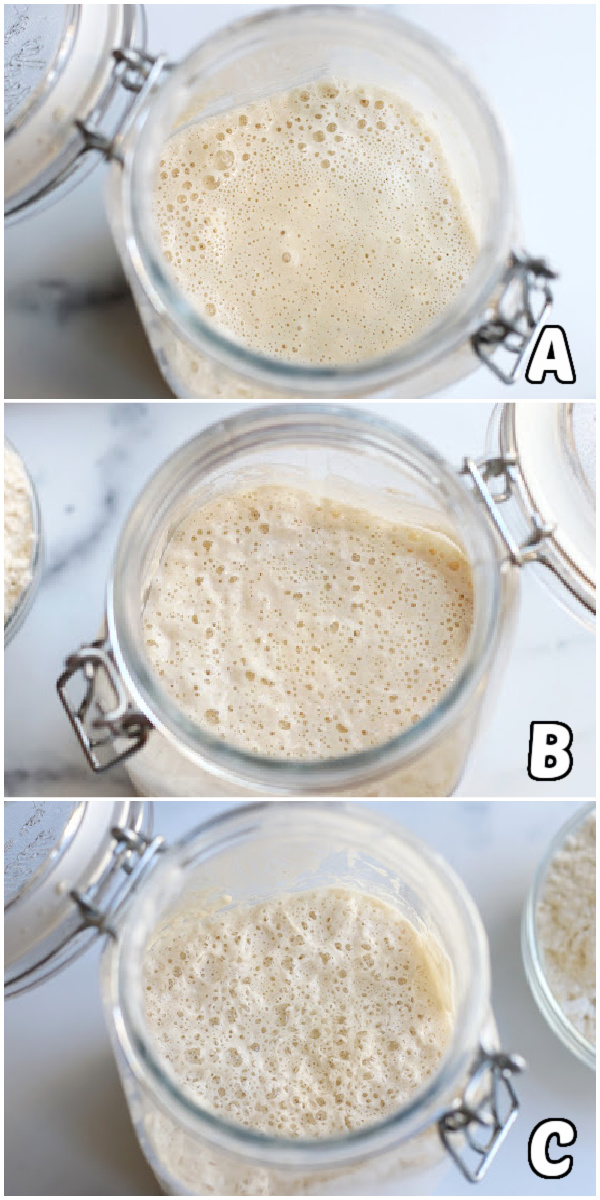
To feed the Sourdough Starter, discard half of it and add 150 grams of flour and 150 grams of water to the remaining Starter. Stir well and let sit at room temperature overnight. If on the second day the Starter has the appearance of photo B, let it sit at room temperature for one additional day before using it in recipes.
Pro Tip#7– If storing the Starter at room temperature it will need to be fed every 2-3 days. If storing in the refrigerator, it can be kept safely for up to 10 days before feeding. Please note that if storing in the refrigerator 2 feedings will most likely be needed before the Starter will look like photo C.
Starter Smell and How to Know if it has Gone Bad
A healthy Sourdough Starter is going to smell sour. Therefore, it is not the best way to judge whether it has gone bad. However, the best way to know is by its appearance. If there are any visible signs of mold or red/orange spots it is time to throw the Starter out and begin again. Take heart though, Sourdough Starters are full of good bacteria. Because of this, chances of it going bad are much lower.
Maintaining Sourdough Starter
For anyone new to sourdough baking, it is incredibly normal to have many questions and concerns about maintaining your sourdough starter. How To Maintain Sourdough Starter has a complete breakdown of the feeding schedule, common concerns and questions so that you can enjoy your sourdough starter for decades to come.
If you enjoyed this Sourdough Starter please let me know by leaving a comment and review below. Doing so helps to encourage others to make the recipe also. Thank you!
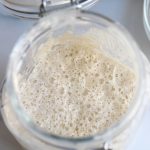
Easy Sourdough Starter
Ingredients
- 700 grams white all-purpose flour *see Note #1 below
- 700 grams filtered water
Instructions
Day 1
- In a medium sized glass bowl mix together 50 grams of water and 50 grams of flour. Stir well and cover. Let sit at room temperature.See Note #2 and Note #3 below.
Day 2
- To yesterday’s mixture add 50 grams of flour and 50 grams of water. Stir well and cover. Let sit at room temperature.
Day 3
- Throw away half of the Starter. To the remaining Starter add 100 grams of flour and 100 grams of water. Stir well and cover. Let sit at room temperature.See Note #3 below.
Day 4
- Throw away half of the starter. Add 150 grams of flour and 150 grams of water to the bowl and stir well. Cover and let sit at room temperature. See Note #4 below.
Day 5
- Similar to the previous days, throw away half of the Starter and add 150 grams of flour and 150 grams of water. Stir well, cover and let sit at room temperature. See Note #5 below.
Day 6
- Throw away half of the starter and add 200 grams of flour and 200 grams of water. Stir well, cover and let sit at room temperature. See Note #6 below.
Day 7
- On day 7 the Starter should at the least look like photo B above if not like photo C. If it has a similar appearance to photo C, it is ready to use. If it looks like photo B, let it sit at room temperature for one additional day.

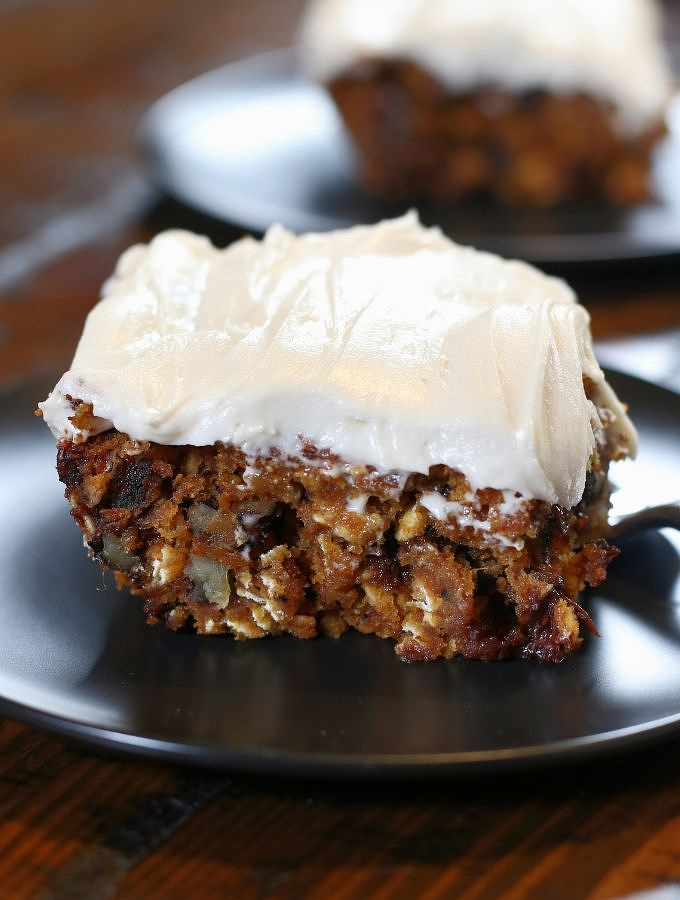

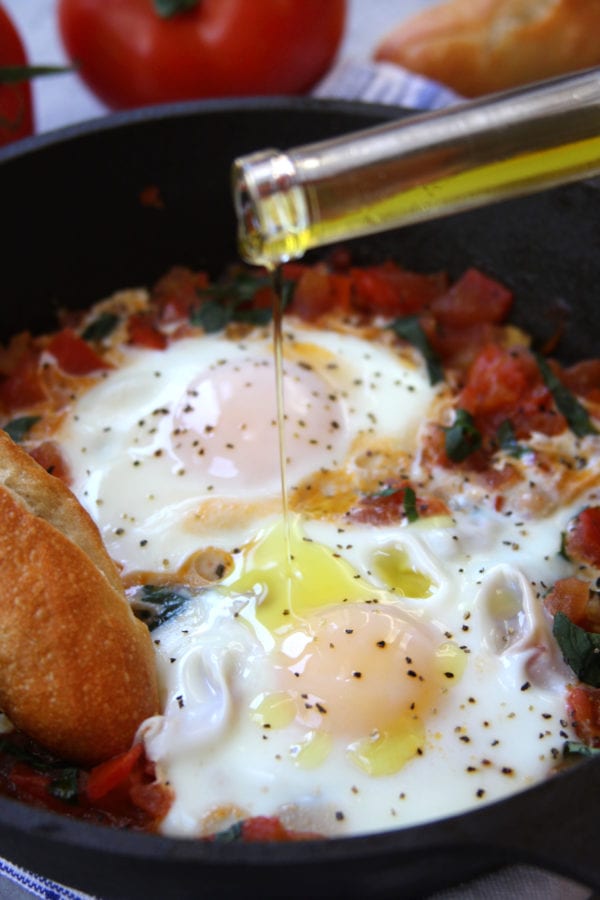
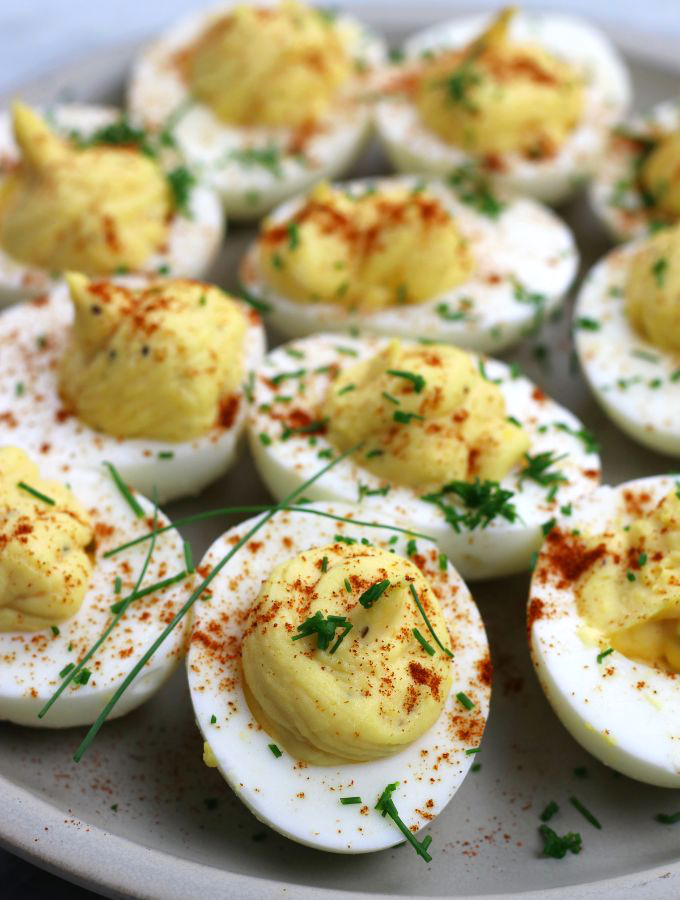

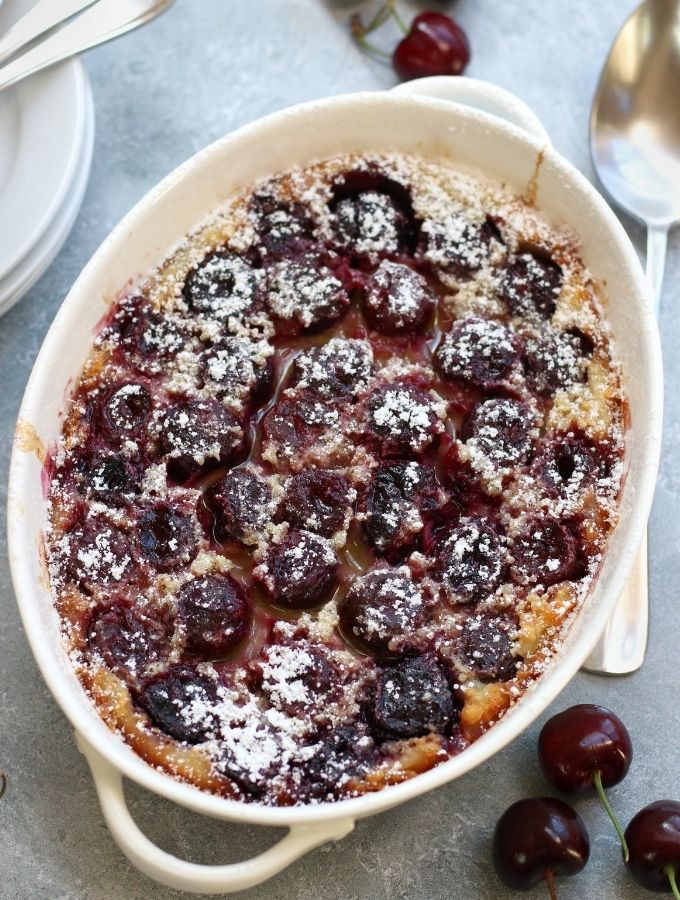
I’m on day 5 and my starter seems dry. It has the sour smell but no bubbling that I can see. What do I need to do?
Hi Margaret. This is such a great question. It sounds like everything is ok. Some starters take a little longer to develop the bubbles. If by 7 or 8 there are no bubbles, then I would reevaluate the type of flour and water. Honestly though, it is really normal for some starters to take just a little bit longer.
Hi Heather. I’m on Day 5 of my first starter and have transferred my mixture to a glass jar. I closed the lid but not fully. Is that correct? And if so, when during the or does the jar get sealed if ever? I read what you said about the glass breaking and I definitely don’t want to do that.
Hi Rachel. I really appreciate this question. I close the glass jar after making bread and when I will not be making bread for awhile. The minute I start feeding it again I cover it with paper towels and a broccoli rubber band (the thick rubber bands that are wrapped around the broccoli bunches).
For the first 6 months I recommend to feed your starter often, so using the paper towels and rubber band is a good idea the first 6 months. Past that, you can start closing the jar in-between bread sessions.
My starter is on day 7 now and is almost ready to be used. I am now wondering what a good amount to feed everyday is? Do I stick with the amount started on day 7 or use a different one?
Hi Rachael. My feeding amounts looks like 150 grams of flour and 150 grams of water. This has been a perfect amount to make reasonable amount of bread with each baking session. Also, as the starter matures, it expands quite a bit. 150 grams of each as kept the starter manageable.
I hope you enjoy the bread. Freshly baked sourdough is the best thing ever!!!
I started this yesterday and have it with a very loose lid in my ceramic casserole dish (no glass bowls in my house!). I had some condensation on the underside of the lid this morning, should I not have the lid on so it can breathe easier or just put a paper towel on top and then cover with the lid? Also, do I need to try to get it closer to 75 degrees instead of 70? Thanks!
Hi Erin! These are such great questions. I cover the starter with paper towels when it is getting close to the point of making bread. At that point the start is incredibly healthy and grows quite a bit when fed and this could possibly break the glass jar that I use. In the beginning of making starter you could go either way with how you cover your starter, depending how dry or humid your climate is.
Because you did have condensation, I am guessing you live in a higher humidity. With that, you may need to increase the flour amount slightly (like 5-10 grams). I can’t tell for certain, but that is my best guess.
Also, it is always wonderful to have an ideal temperature of 70-75℉, but don’t worry if you can’t achieve that. The starter will still work but may need just a little more time in-between feedings.
I hope this helps.
Help! Yesterday, day 7, due this COLD weather we put the started next to floor vent and it performs much better! While at work my husband discarded half and only fed 50 gm each of flour and water. Now it looks like it did day 4, small bubbles! Should I discard and feed again or just feed more. I’ve placed on a heating pad on low and plan to monitor for to high of heat. Adjusting with towels under as needed.
Thanks!
I am so sorry Lindsey that you are having to deal with the miserable cold.
First off, don’t worry. The starter is not ruined. I would go ahead and feed it 100 grams each of water and flour today (no need to discard anything today) and then discard half tomorrow and feed it 150 grams each of water and flour. In a few days it should be ready to go again. You may need one additional day of discard and feeding 150 grams of each past tomorrow before making bread. Keep me updated on how it goes and stay warm!
I used this recipe STEP BY STEP and by day 4 I had an amazing sourdough starter!!
That is wonderful to hear!! Thank you Carley.
What do you do after day 7? I see you mention if it stays on the counter to feed 150g flour + 150 water for a good good amount – is that daily? Do you still have to discard some as well? Curious what maintenance looks like if you’re hoping to make 1-2 loaves a week in a perfect world
Hi Rachel. These are such wonderful questions. I am a day away from publishing How To Maintain Sourdough Starter. It will have a complete breakdown, making the maintenance so much easier.
For how you want to approach sourdough, You can let your starter sit undisturbed for about 3 days out of the week and then start the discard and feeding process to prepare it for a once a week bread baking session.
How to Maintain Sourdough Starter is live. https://www.thefedupfoodie.com/how-to-maintain-sourdough-starter/
Thank you!
I used your method and it worked amazing! I now have a super strong starter. Thank you for this recipe.
I am so happy to hear!! I hope you have many years of delicious sourdough baking!
Hello!
I’m on day #7 and my starter is looking great! I fed her yesterday morning and this morning she had doubled in size and beautiful bubbles like ex photos B/C. I’m wondering about the smell. It doesn’t really smell sour but more doughy.. ? Has something gone wrong or should I stick with it and the smell will come?
This is my 3rd attempt at a homemade starter and this has gone perfectly so far other than the smell
Hi Samantha. I am so happy to hear all is going well. When a starter is new it is very common for it to not have the sourdough smell right away. Some types of flours will lend more to developing the smell quicker than others. Don’t worry though because as it matures it will start to smell more and more like sourdough. I would love to hear how the bread turns out, so keep me updated.
Can you use GF measure to measure flour? Or would gf bread flour be better? Or any suggestions for GF flour?
When you measure 50grams of flour, or any amount, 100 grams, 150grams, etc & then 50, 100, 150, of water, are using them as dry vs wet measurements? Or just 50 grams of each.
Hi Stacy. I haven’t yet taken on gluten free sourdough. It is something I am planning on, but I just haven’t gotten there yet. I do know though, white rice flour, brown rice flour and quinoa flour have been used by some successfully. I just don’t know the ends and outs of it yet.
I’m totally new to sourdough and attempted to start one 4 days ago. It doesn’t look anything like your pictures. It has liquid separated on top and smells hellish 😬 I’m assuming this isn’t normal and that I should just start over?
Hi Michelle. Actually, it depends. All could be ok with the starter. It may just need a bit more time. I just published this post that may be of help. https://www.thefedupfoodie.com/how-to-maintain-sourdough-starter/
Hello I’m on morning of day 5. Days 1-4 my starter seemed like it was on a good path it was doubling in size there was bubbles like picture C but it was watery which I believe that because it’s eating quicker than my feedings. I read it could be due to the heat, my house is generally cold so I put it in a warmer area during those days. The night of day 4 I opted to move it to not so warm place and this more there was no growth and water on top. My schedule has been every morning around 6am feeding it. Should I move it back to the warmer area and double my feedings?
Hi Amber. Even when temperature is consistent, it is very common for a new starter to appear like it is loosing umpff. It is not a bad idea to move it back to the warmer area, but if you can’t, it is ok. It sounds like it needs about 3-4 more days of being fed before it will be ready for bread making. Also, this post may help. The hooch you are seeing (water on top) is incredibly normal. https://www.thefedupfoodie.com/how-to-maintain-sourdough-starter/
Hi! I started using you recipe for starter on Wednesday and so far so good! I do have a question though; my starter is about to outgrow the jar I have it in if I add the 200g water and 200g of flour for today’s feeding. Should I discard more than half, not feed as much or move it to a different jar?
Hi Christina. It sounds like your starter is incredibly healthy. I would discard more than half or you can separate the starter and share with a friend. Keep me updated on how it goes and how the bread turns out.
Hi! I am wondering rather than throwing 1/2 away at the beginning, can I use it to make another stater for my daughter? Thank you!
Hi Tisha. That is a great question. I would recommend to follow the 7 days of starter preparation and once that is completed, sharing the discard is a great idea.
Hi! I was wondering what do I do if I accidentally did 150g of each on day three when I was supposed to only do 100g? Do I start from scratch or is there a way to fix this?
Hi Victoria. I think your starter will be fine. It may just take a day or two longer of feeding to get it ready to make bread. Please let me know how it goes but don’t loose heart if it takes just a little bit longer.
Hi there!
I am on day 6, I discarded and my starter really has very little bubbles. I am using King Arthur all purpose flour. I do keep my house pretty cool daily. I am hoping that it is save able and will eventually work! I’m looking for advice!
Hi Macy. It sounds like everything is ok and your starter just needs a few more days of feeding. It is a good sign if there are bubbles. This post may help also. https://www.thefedupfoodie.com/how-to-maintain-sourdough-starter/
I would love to know how it is going over the next few days.
Hello my name is Jeannette I’m on day four and I was supposed to empty half of the starter out and put all the new starter in. I forgot to empty the starter I need to know is it still going to be OK to Carry on? Thank you.
Hi Jeannette. You are not alone. It is a common hiccup that happens. It may delay the starter by a day or two, but should develop none the less. When you go to do the next discard, just do a touch over half and continue with the steps. Also, I just published How To Maintain Your Sourdough Starter post that may also be helpful. https://www.thefedupfoodie.com/how-to-maintain-sourdough-starter/
Hi! I’m on day 4 with my starter. It looks great. I’m just feeling a little nervous about the maintenance of it. Does it need to go in the fridge? Does it need to be fed every day or only after I use it?
Hi Andrea. I am so glad you asked. I just published a detailed post addressing all the ins and outs of maintaining your starter. I hope it helps. https://www.thefedupfoodie.com/how-to-maintain-sourdough-starter/
Hi! I’m on day 5 and my starter just had maybe has a dozen bubble right at the top only it’s not growing or doubling 1st 2 days it looked great but than 3-5 looks like it’s not doing anything. I’m using king bread flour and bottled water . Not sure what’s wrong or if this is normal. Also the temp is between 69-89. I’d post a picture but it won’t let me. Thank you
It sounds like you are just a few days away from having a healthy starter. Just keep going and don’t loose heart. How to Maintain Sourdough Starter may help also. https://www.thefedupfoodie.com/how-to-maintain-sourdough-starter/
Hi there,I have read all the comments and just need some reassurance I guess. I’m on day 6 and am measuring with the scale but seems runny. I’ve never made sourdough before so not sure if that is the consistency I am supposed to be at on day 6. There is a little water on the top and once I mix it I do get bubbles. Should I use less water? Or just feed again on day 7? Besides the bubbles should it be runny, or more dough like? Thank you!
Hi Michele. It is not uncommon to have the starter take a little longer to develop. When you see the water on top (hooch) it is a sign that it needs to be fed. Also, if you feel like the starter is looking too runny it is absolutely a good idea to feed it slightly less water (I would try 20-25 less grams). Based on what you are sharing, it sounds like you are about 2-3 days away from it being fully developed enough to make bread.
I just published How To Maintain Sourdough Starter post that may also be helpful Please keep me up to date on how it goes. https://www.thefedupfoodie.com/how-to-maintain-sourdough-starter/